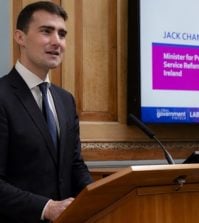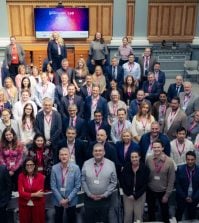Pointing the way forward on civil service reform

Delivering reforms means “changing the engine as the plane is in flight”, Singapore’s civil service head Leo Yip told colleagues from 17 countries at the 2020 Global Government Summit. Matt Ross learns how Australia and New Zealand are tackling the complex, multi-dimensional challenge of getting transformation programmes off the ground
“People have very high expectations of us,” said Katherine Jones, citing the Australian bushfires as an example. “People feel that government needs to be there right beside them when they’re in a crisis: to respond immediately, to reach them in remote locations, and to meet their specific needs.”
And as well as reacting well when emergencies arise, citizens want their governments to head off such dangers – acting to halt climate change, for example. Despite people’s growing “cynicism about both the political class and the bureaucratic class”, they expect governments to be transparent, responsive and effective, said Jones, who’s the Deputy Secretary of Australia’s Department of Finance. But if governments are to protect their populations’ interests in an ever more complex, interconnected and unstable world, they must reform their operations and build new capabilities – all whilst keeping the service delivery show on the road.
This is a huge task, demanding simultaneous action on many fronts. Illustrating the various planes of civil service reform for delegates at Global Government Summit – an international gathering that attracted top civil servants from 17 countries to Singapore earlier this year – Leo Yip, Head of the Singapore Civil Service, listed some of the “dualities” required of today’s civil service leaders.
“One duality is to be able to both design policy, and execute it,” he explained. “Then you’ve got to balance organisational leadership with collective leadership – deciding when to subjugate your organisation’s interests to collective decisions. A third duality is that between your ‘vertical’ domain – health, defence or trade and industry – and the ‘horizontals’ such as personnel and technology. Then there’s the duality between influencing internal stakeholders, including ministers, and people outside the system. And the final duality is the tension between delivering what we have to do every day, and building the public service of tomorrow.”

And it’s not just the difficulty of developing reforms that function across each of these axis that makes life awkward for civil servants running transformation programmes: the delivery environment is itself almost uniquely challenging. When Australia brought in consultants to assist with talent management, recalled Jones, “they were absolutely blown away by the level of complexity that senior civil servants are dealing with”: she cited the political environment, risk-management issues and senior leaders’ breadth of responsibilities as particular issues. John Manzoni, then Chief Executive of the UK Civil Service and a former BP executive, wholeheartedly agreed: “Public sector leadership is much more complex than private sector leadership, because you’ve got to give advice and ask questions upwards on the ‘what’, but drive progress downwards on the ‘how’,” he said.
Do it or lose it
Yet unless civil service leaders initiate and drive substantive reforms, they’ll lose control of the agenda, warned Suma Chakrabarti, President of the European Bank of Reconstruction and Development (EBRD). During his days as a UK permanent secretary, he recalled, then-PM Tony Blair complained that “he couldn’t get things done because the bureaucracy was stopping him. That led to people like me devising some reforms: I realised that I never wanted to be in that position again. It’s important for the civil service leadership to get political support for reforms before being told you’re obsolete and in the way.” The question, he added, is: “Whose change is it? It’s important to find moments when the politicians need you and your will to drive change in order to get their agenda delivered.”
That message will chime with civil servants in both the UK – where Cabinet Office minister Michael Gove and the PM’s chief adviser Dominic Cummings are taking control of the civil service reform agenda – and Australia, where a review commissioned by prime minister Malcolm Turnbull has shaped the course of reforms. Turnbull’s review, explained Jones, followed work by the Secretaries Board – a group of civil service leaders working “at the policy level to drive policy and cultural reform” – to implement changes in fields such as digital and data, capital investments, workforce and productivity. This programme “had the benefit of being driven by the heads of agencies in a collective way: leaders had rolled up their sleeves and invested their authority in the reform process,” she commented. But the work “wasn’t always visible to the service or the public,” she added, emphasising the importance of “demonstrating that you’re undertaking reforms.”
PM Turnbull was, recalled Jones, concerned that “we weren’t prepared for what we’d need to be doing not just in 2020, but in 2030 and 2040.” And in 2018 he asked businessman David Thodey to pick up the baton, assembling a commission to make recommendations. Thodey’s report was published alongside the government’s response in December 2019, just as new prime minister Scott Morrison announced the merger of several departments of state – cutting their number from 19 to 14. These amalgamations were designed to “create integrated mega-departments where the desire is that horizontal integration can happen more readily,” explained Jones. “Also, the prime minister wanted to reduce the level of bureaucracy, with fewer high-level bureaucrats and a greater focus on people at the coalface”.

After Thodey submitted his report, Jones explained, the Secretaries Board was given time “to work through the recommendations and provide advice to government about an appropriate response to each.” The government then made a call on each recommendation, while civil service leaders established an Implementation Unit in the Department of Prime Minister and Cabinet. The responsibility for delivery falls collectively on departments’ chief operating officers, said Jones, adding that performance management frameworks may be adjusted to emphasise their shared responsibilities.
The power of public service
“How did you get support from the public servants in Australia in driving reform?” asked Pg Hj Md Sarifuddin, from the Prime Minister’s Office in Brunei, as Manzoni highlighted “one of the problems with independent reviews: it’s always somebody else’s idea.” The keys to success lie in staff engagement, replied Jones: “We need to keep engaging to meet the expectations of our workforce: they want to work in an evolving organisation, and they want to contribute to meeting the challenges.”
The work undertaken to date – both by the Secretaries Board, and through the consultations mounted by Thodey’s commission – have “instilled an inclination for innovation and reform and change,” Jones added. From the idea that “we’ll do a sprint of change then all stop and take a deep breath, we’re moving to a sense that change is ongoing.” But to mobilise civil servants behind uncomfortable change programmes, she argued, leaders will have to give them “a better line of sight to how their work impacts on citizens and businesses,” creating “a sense of purpose and an understanding of how their work contributes to achieving a greater outcome.”
That made good sense to Chakrabarti, who looked back over his experiences securing workforce buy-in for change programmes. Where staff “are very mission-oriented – the Department for International Development, parts of the Ministry of Justice, the EBRD now – we had to convince people that the reform would allow them to deliver the mission they came into work for, because they got out of bed for the mission,” he said. “But in some places, a lot of staff are not as mission-oriented. And there, it was vital to design a reform programme that showed how their jobs would be better if we could deliver the reform.”
Aligning action, not structures
In New Zealand, explained Hannah Cameron – Deputy Commissioner in the country’s State Services Commission – the civil service reform programme has been designed to build that sense of common purpose and public mission. Side-stepping major organisational changes, she said, its goal is to create a more collegiate, collaborative leadership cadre: one suited to a “more ambiguous, organic world which requires an emotional, human, cultural response.”

In the 1980s and ‘90s, she recalled, New Zealand gave many of its agencies far greater operational autonomy. This freed them up to focus on delivering their goals, but “with that devolution came a lack of alignment across the system, making it more difficult to collaborate.” The centre had given up the levers to coordinate action on issues such as digital transformation, she commented: recently “there has been a move towards building cross-cutting collaboration, but it’s very much working against the grain.” And agencies’ strong sense of individual identity led to a loss of a sense of shared purpose – weakening the “motivation that brought public servants to be there in the first place.”
So political and civil service leaders set about “reconnecting the public service with its shared identity and common values” – producing legislation that both creates “instruments for collective accountability and system leadership”, and sets out the principles and purposes underpinning public sector operations. The goal, she explained, is to “provide a sense of common mission that will give a bedrock to collaboration” – compensating for agencies’ “different structures, different accountabilities and different funding mechanisms,” and fostering “a public service that can rally around a common mission”.
Principles to unite behind
The legislation, Cameron said, sets out “a number of principles that underpin public service: political neutrality, merit-based selection, free and frank advice, open government, and stewardship.” On stewardship, for example, the new law gives civil service leaders a duty to consider and address long-term issues such as climate change, intergenerational disadvantage and digital disruption, addressing a concern that “chief executives find it difficult to devote resources to these matters, because ministers want to see resources diverted towards their short-term priorities.” Officials will, for example, have to produce triennial briefings on long-term challenges – ensuring that they’re not forgotten amid the daily rush to deliver the government’s agenda.
The Welsh government, noted Manzoni, has also legislated to protect civil servants’ duty to consider long-term issues. And he raised another key aspect of planning ahead: the need to maintain investment in civil service buildings, IT systems and remuneration. “It’s not sustainable to keep giving civil servants a 1% annual pay increase,” he said: after a period during which “investment was hollowed out,” he added, “we’re building a programme now to invest in people, legacy IT and the backlog of maintenance across the estate.”
For Matthias Freundlieb, Deputy Director-General in Germany’s Federal Chancellery, New Zealand’s approach provided “a model to make the public service more attractive, motivating people to join.” Demographic and economic changes in Germany have left its public sector facing growing recruitment challenges: “Studies predict that there will be up to 800,000 vacancies by 2030,” he said. “In the federal administration, about 40% of employees will have retired by then.”

A focus on realising the potential of merit-based recruitment – tackling discriminatory processes and unconscious bias to hire and promote a more diverse workforce – can help address staffing challenges, replied Cameron. “We have an ageing white European population, but a healthy young Pacific Peoples population – and Pacific Peoples have a strong sense of community service that really fits with the public service,” she said.
Wanna’ be starting somethin’
New Zealand’s reform programme, Cameron summarised, is designed to harness civil servants’ sense of mission – powering the reforms and collaboration required to improve services. “We need a drive for improvement, but at the same time we want to uphold and preserve what’s good about the public service,” she said. That’s a powerful engine, responded Manzoni: “When I arrived in the UK civil service, I was absolutely blown away by the passion that our people have to serve the public,” he said. “The question is how to create a sense within the public sector workforce that they own the execution and delivery.”
“We have to create a ‘burning platform’ and make the case for change, while delivering excellent services today. As public sector leaders, we face the complex task of changing the engine as the plane is in flight, without letting it fall out of the sky,” said Yip. “We have to create the impetus for change, and take the risks that come with change.”
The value of the Global Government Summit, he concluded, lies in its ability to help civil service leaders navigate their way through that complexity and ambiguity. “It’s a unique gathering. There are many challenges and opportunities that we have in common around the world, and here we can discuss them and learn from each other,” he said. “As the title of the Michael Jackson song goes: ‘You are not alone’.”
This is the fourth and final part of our report on the 2020 Global Government Summit, held in Singapore at the end of January – before COVID-19 spread beyond the Far East, and Sir John Manzoni stepped down as Chief Executive of the UK Civil Service. While the event is held under the Chatham House Rule, we ask delegates to approve quotes for use in these reports – enabling us to share civil service leaders’ key messages and perspectives with our readers.
Part one covered the debate on addressing inequality. Part two explored how to address the barriers to interdepartmental collaboration, enabling governments to achieve their wider goals. And part three examined how civil services can recruit and develop the specialist skills needed to address today’s public policy challenges.
A list of the Global Government Summit 2020 attendees can be found here.
About Matt Ross
Matt is Global Government Forum's Contributing Editor, providing direction and support on topics, products and audience interests across GGF’s editorial, events and research operations. He has been a journalist and editor since 1995, beginning in motoring and travel journalism – and combining the two in a 30-month, 30-country 4x4 expedition funded by magazine photo-journalism. Between 2002 and 2008 he was Features Editor of Haymarket news magazine Regeneration & Renewal, covering urban regeneration, economic growth and community development; and from 2008 to 2014 he was the Editor of UK magazine and website Civil Service World, then Editorial Director for Public Sector – both at political publishing house Dods. He has also worked as Director of Communications at think tank the Institute for Government.



Related Posts
Latest News
-
How governments are using mobile IDs to transform services for citizens
As governments around the world look to deliver digitally-enabled services,...
- Posted July 14, 2023
- 1
-
Global Government Forum research reveals the top factors that enable civil service innovation
Support from leaders, a culture of open communication and risk-taking,...
- Posted June 19, 2025
- 0
-
UK government to boost civil service AI skills in latest One Big Thing campaign
The UK civil service has said it will launch its...
- Posted June 19, 2025
- 0
-
Women’s Network news roundup: near gender parity in Canada’s new Cabinet – and the mountain Japan has to climb
GGF brings you the latest roundup of women-focused and gender...
- Posted June 18, 2025
- 0
-
Building blocks of modern government: the digital identity opportunity
Digital IDs can unlock government service transformation – but delivery...
- Posted June 18, 2025
- 0
-
Relive all the sessions from Innovation 2025
Thousands of delegates flocked to London in March to hear...
- Posted June 18, 2025
- 0
-
How to lead public sector data and digital transformation
Insight on how to use data and digital integration to...
- Posted June 17, 2025
- 0
-
Projects shortlisted for Canada Public Service Data/AI Challenge
Four projects focusing on how to better use data or...
- Posted June 17, 2025
- 0
Partner content



Related events

















